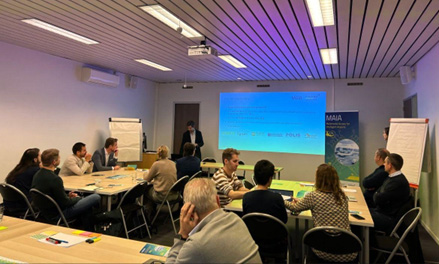Meet MAIA, the SESAR-funded project using artificial intelligence and data analytics to pioneer multimodal airport access.

Mobility is experiencing an evolution, with each passing year introducing novel and innovative modes of transportation that reshape our ways of travelling and interacting with the world. One clear example is the transformation of airport access. In the near future, airport access options will expand to include shared autonomous vehicle fleets (shared driverless shuttles) and electrical eVTOL vehicle fleets (passenger drones).
While these new forms of transport open the door to exciting new opportunities for the sustainable transport of goods and people, they also create new challenges. Chief among these challenges is figuring out how to safely integrate such vehicles into today’s airspace and airports – both of which are already facing a capacity crunch.
“It is quite clear that new smart mobility concepts represent a huge potential for the aviation sector,” says Ines Peirats, Transport Systems Product Manager at Nommon. “What isn't so clear is how to take advantage of that potential."
Helping bring some clarity to the issue is the MAIA project.
Funded by the SESAR 3 Joint Undertaking and coordinated by Nommon, the MAIA project looks to better understand how we can use mobility innovation as a vehicle for improving airport access. “We intend to provide the data and tools we need to maximise mobility innovation’s contribution to the competitiveness and sustainability of the European aviation sector,” adds Peirats.
Three tools. One goal.
To start, the project brought together transport planners, transport modellers, airport managers, and mobility service providers from across Europe. “We took a deep dive into the opportunities and risks associated with passenger mobility innovations within a multimodal airport access context,” remarks Peirats.
From these initial discussions, the project defined the high-level requirements of the three solutions planned in the project: the MAIA-Engine, MAIA-CCAM and MAIA-UAM. The joint integration of these solutions will prepare the aviation sector for the optimal implementation and operation of innovative multimodal airport access services based on cooperative, connected and automated mobility (CCAM) and urban air mobility (UAM) technologies.
The proposed MAIA-ENGINE will use machine learning models and big data to analyse passenger profiles and to model and predict demand for airport access. “Once developed, this particular toolset can be used to monitor and anticipate how the availability of new passenger mobility solutions will impact passenger behaviour,” notes Peirats.
Autonomous vehicles to the rescue
This data can then be fed into the MAIA-CCAM tool to help, for example, optimise the dispatching of autonomous vehicles based on actual demand and other factors.
According to Peirats, having ready access to this type of information will help airports and transport providers mitigate the impact of disruptions along the multimodal value chain. “MAIA-CCAM will help dispatchers meet the expected demand of CCAM trips to fill in any gaps along the door-to-door journey.”
Identifying the best locations to build vertiports
The forecasted demand data will also be provided to MAIA-UAM, which will be responsible for identifying the most suitable locations for vertiports within airport premises and urban areas.
“Our MAIA-UAM tool is being designed to help identify the best locations for building the vertiports that eVtols will use to transport passengers,” explains Peirats.
The tool will utilise an algorithm that takes into account passenger experience criteria. This includes a desire to reduce the time it takes to get from door-to-gate. The tool will balance these passenger criteria with such U-space requirements as obstacles and weather, amongst others.
Laying the foundation for a multimodal aviation ecosystem
Once developed, all three tools will be fully tested and validated at actual European airports, including Brussels Airport and Madrid Barajas.
In the meantime, the project is currently focused on advancing the algorithms and models on which the solutions will be based. The project team is also working to define the specific use cases that will eventually be used to validate the tools.
“MAIA will enable aviation stakeholders to make evidence-based decisions on how to implement, operate, and regulate new services in a way that improves the passenger experience and helps aviation meet its sustainability goals,” concludes Peirats.
As a result, the project is confident that CCAM- and UAM-based services will be a fully integrated part of a multimodal aviation ecosystem within the next 5 to 10 years.
More about MAIA

Stakeholders gather in Brussels for a MAIA workshop where they discussed the opportunities and risks associated with passenger mobility innovations in a multimodal airport access context.
